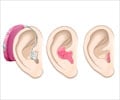A new research has found that hearing through somebody else’ hears could be quiet different.
A new research has found that hearing through somebody else’ hears could be quiet different. BBSRC scientists claim that the auditory cortex, the part of the brain that deals with sound, is adapted in each individual and tuned to that particular person’s surrounding. Therefore hearing from another person’s ears could be different.
The research, which features in the current issue of BBSRC Business, could help to develop more sophisticated hearing aids and more effective speech recognition systems.The research team at the University of Oxford, led by Dr Jan Schnupp, have studied the auditory cortex of the brain and discovered that its responses are determined not merely by acoustical properties, like frequency and pitch, but by statistical properties of the sound-scape. In the world loudness and pitch are constantly changing. The random shifts in sounds are underpinned with a statistical regularity. For example, subtle and gradual changes are statistically more regular than large and sudden changes. Dr Schnupp's team have found that our brains are adapted to the former; the neurons in the auditory cortex appear to anticipate and respond best to gradual changes in the soundscape. These are also the patterns most commonly found in both nature and musical compositions.
Dr Schnupp, a research leader at the University of Oxford Auditory Neuroscience Group, said: "Our research to model speech sounds in the lab has shown that auditory neurons in the brain are adaptable and we learn how to locate and identify sounds. Each person's auditory cortex in their brain is adapted to way their ears deliver sound to them and their experience of the world. If you could borrow someone else's ears you would have real difficulty in locating the source of sounds, at least until your brain had relearned how to do it."
Dr Schnupp has also found that the auditory cortex does not have neurons sensitive to different aspects of sound. When the researchers look at how the auditory cortex responds to changes in pitch, timbre and frequency they saw that most neurons reacted to each change. Dr Schnupp explains: "In the closely related visual cortex there are different neurons for processing colour, form and motion. In the auditory cortex the neurons seem to overwhelmingly react to several of the different properties of sound. We are now investigating how they distinguish between pitch, spatial location and timbre.
"If we can understand how the auditory cortex has evolved to do this we may be able to apply the knowledge to develop hearing aids that can blot out background noise and speech recognition systems that can handle different accents."
The Oxford team's current project is using BBSRC funding to fit trained ferrets with harmless auditory implants. The animals are trained to respond to different sounds and the implants enable the team to observe the auditory neurons as the ferret responds to different sounds.
Advertisement
Source-Eurekalert
LIN/M









